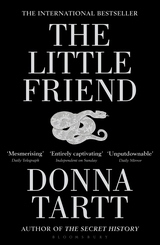Just Finished Reading: “The Little Friend” by Donna Tarrt
 Donna Tarrt is a significant name amongst American writers. Recently, she won the Pulitzer Prize for The Goldfinch (2013) and the novel I have just read, The Little Friend (Bloomsbury, 2005 edition; first published 2002) won the WH Smith Literary Award in 2003.
Donna Tarrt is a significant name amongst American writers. Recently, she won the Pulitzer Prize for The Goldfinch (2013) and the novel I have just read, The Little Friend (Bloomsbury, 2005 edition; first published 2002) won the WH Smith Literary Award in 2003.
Ms Tarrt is also from the American South—and so, too, is The Little Friend. I have never set foot in the Americas but I have read the works of Mark Twain, William Faulkner, and Harper Lee, and knew at once that I was in the American South—in this case the Mississippi (Tarrt’s home state) of circa 1979. The culture of the storytelling is as distinctive as a physical landscape.
In terms of style of fiction, The Little Friend falls into the Contemporary Realism genre: it is a “slice of life” story, that in the customary approach of the genre, takes an indepth look at a period in the characters’ lives, without necessarily trying to explicate events or resolve problems and/or mysteries. In this case, the mystery is the inexplicable and unresolved death of small boy, which twelve years later continues to haunt his family. The immediate family unit has disintegrated: the father living out-of-state, the mother retreated into herself, and the two sisters left largely to their own devices. A grandmother and three great-aunts, together with a housekeeper, intersect with the nuclear family to a greater or lesser degree—but the story focuses around twelve-year-old Harriet’s decision to track down her brother’s killer. In doing this, she focuses on a “poor white” (“trailer trash”) family with a history of criminal activity, who are currently focusing their collective energies on manufacturing methamphetamine. This family, the Ratliffs, are the second axis of the story, although other characters weave in and out of the narrative. Eventually, the Ratliffs’ activities and Harriet’s investigation enter a collision course…
The strength of the story is the evocation of the small-town, Southern community and the reality of the characters. A comment on the back cover alludes to “Southern Gothic” and there are elements of both the surreal and the macabre to aspects of the story—but more importantly, I feel, this is about the “grindingly real”: whether it is the faded gentility of the grandmother (Edie) and her sisters, or the poverty, criminality, addiction, and psychiatric illness of the Ratliff family. In terms of the reality of the characters, there is no sugar coating or comfortable—and reassuring—cliches on which to hang your reader’s hat. No character is entirely sympathetic, but none is completely unsympathetic either; uneasiness and discomfort abound, and there is no clear moral compass.
Not surprisingly, therefore, I must advise that The Little Friend is not what I would call an “easy read”; sticking with it definitely required perseverance on my part as reader. The aspects of the book I found difficult, however, were not the unvarnished and unattractive realism of the characters, but the intrusion of authorial asides, usually in parentheses, that were superfluous to understanding of the story. Similarly, although the evocation of the small-town Mississippi world was powerful overall, sometimes the story got bogged down in detailed descriptions that, however beautifully written, pulled me out of the narrative flow and dissipated the development of the story. So much so that I was reminded of Ursula Le Guin’s stricture that: “The chief duty of a narrative sentence is to lead to the next sentence … [because] the basic function of the narrative sentence is to keep the story going and keep the reader going with it.”
So overall, did I enjoy this book? I thought it was interesting, but not absorbing—I found it easy to put down and could equally easily not have finished it. The strength of the book was character study and while interesting, I did not feel it offered me new and compelling insights. So I suppose my response could best be described as ambivalent: while I would read another book by Donna Tarrt, I will not hasten to do so. Reading, however, is a subjective pastime and the number of glowing commendations from mainstream literary reviewers indicate that my response is by no means universal—particularly, I suspect, for readers who enjoy Contemporary Realist fiction generally and/or the literature of the American South.
—
Additional Information:
I read the UK, mass market edition of this book, 555 pages, published by Bloomsbury in 2005.







